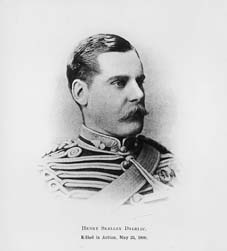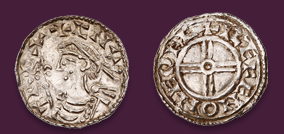
Auction: 4004 - Orders, Decorations, Campaign Medals & Militaria
Lot: 67
A Senekal Casualty Group of Four to Major H.S. Dalbiac, 34th Imperial Yeomanry, Late Royal Artillery Egypt and Sudan 1882-89, dated, one clasp, Tel-El-Kebir (Capt. H.S. Dalbiac F/1. Bde. R.A.); Queen's South Africa, two clasps, Cape Colony, Orange Free State (34/Co. Imp: Yeo:); Order of the Medjidieh, 4th Class breast Badge, by Paul Stopin, Paris, with rosette, red enamel damage; Khedive's Star, 1882, very fine or better, with photographs of the recipient, and some research (4) Estimate £ 800-1,000 Major Henry Shelley Dalbiac, born 1850 at the family seat of Durrington Manor, Worthing; educated Eton College 1863-1866 and the Royal Military Academy, Sandhurst 1868 where he won the 'Bugle'; joined the Royal Artillery 1871; Captain, 1881; served in Egypt 1882 with 'F' Battery, 1st Brigade; Aide-de-Camp to Brigadier General W.H. Goodenough at Tel-El-Kebir; during the battle Major Dalbiac was severely wounded, having had his horse shot from under him (Mentioned in General Wolseley's Despatches); rose to the rank of Major whilst seeing service in India with the Regiment, 1883-1887; resigned commission 1887. After the disaster of 'Black Week' 1899 in South Africa, the War Office decreed for the need for mounted troops, hence the creation of the Imperial Yeomanry, and Major Dalbiac played an integral part in the raising of the 34th Company (Middlesex) Yeomanry; gazetted Captain, 1900; the 34th and the 35th later forming 11th Battalion which for the greater part of it's campaigning was a part of the 17th Brigade commanded by Major-General Boyes; also took employment as Illustrated London News' correspondent to report from the front; embarked White Star SS Cymric and arrived South Africa 23.3.1900; after several reconnaissances in and around Ladybrand, Abram's Kraal, Leeuwfontein and Pardevlei, the 34th Company was given the honour of being the advance guard in General Rundle's advance towards Senekal; at 5.30am on the day of the advance Major Dalbiac set off with his sixty men at the gallop, at the head of the General's force. By 10.00am Dalbiac's party had come within sight of Senekal, however due to the arduous pace that had been set by the expert horseman, a number of his men were lagging behind. Unsure whether the town was still in enemy hands, Dalbiac spurred on alone and demanded the towns surrender. After questioning the inhabitants, he was left with the somewhat dissapointing news that the Boers had left earlier that morning. Having returned to his waiting troops, he decided to enter and secure the town for General Rundles' advance. Whilst in the process of doing this the Yeomanry were fired upon from a Kopje overlooking the town. Dalbiac's immediate reaction was to jump onto his horse and charge the uphill position. Despite his horse falling twice during the ascent, he managed to get his men in a position to order the dismount. However, whilst calling for his Sergeant Major (Roller) he received a gun shot through the jugular and was fatally silenced mid call, 'He was a victim, as so many have been in this campaign, to his own proud disregard of danger' (extract from 'The Great Boer War' , C. Doyle). His horse, also fatally wounded, in its panic rolled on top of the Major thus preventing his men from retrieving their commanding officers' body. Five Yeomen were killed in the attack, four wounded and thirteen taken prisoner, with the rest of the party led by Sergeant Major Roller managing to make it back to Rundle's advancing troops. Trooper Lee, one of those unfortunate to have been taken prisoner, attempted to remove Major Dalbiac's watch in an effort to return it to the family. A Boer guard saw him do this, however, and not only confiscated the watch but then proceeded to rifle through the rest of the fallen Major's possessions, even to the point of taking Dalbiac's medal ribbons. Lee took his protest to the Boer Commandant, who, in turn oversaw the return of the possessions. Major Dalbiac's body was later recovered on the same day, by General Rundle's men. The fallen Yeomen where buried with full military honours at Senekal Cemetry, the name of Major Dalbiac being later inscribed in The Royal Artillery Memorial in St. James's Park, the Eton College Memorial, and also on memorials in St. Jude's Church, South Kensington and St. Paul's Cathedral. Five months after Major Dalbiac's death a ballad was composed in his memory and was soon embraced as the ballad of the 34th Company (Middlesex) Imperial Yeomanry; it has been suggested by Carrington (Rudyard Kipling's biographer) that Dalbiac was possibly the inspiration for Kipling's poem 'The Jacket' , based on his time in Egypt.
Sold for
£3,300




